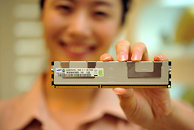- Joined
- Oct 9, 2007
- Messages
- 47,901 (7.37/day)
- Location
- Dublin, Ireland
| System Name | RBMK-1000 |
|---|---|
| Processor | AMD Ryzen 7 5700G |
| Motherboard | Gigabyte B550 AORUS Elite V2 |
| Cooling | DeepCool Gammax L240 V2 |
| Memory | 2x 16GB DDR4-3200 |
| Video Card(s) | Galax RTX 4070 Ti EX |
| Storage | Samsung 990 1TB |
| Display(s) | BenQ 1440p 60 Hz 27-inch |
| Case | Corsair Carbide 100R |
| Audio Device(s) | ASUS SupremeFX S1220A |
| Power Supply | Cooler Master MWE Gold 650W |
| Mouse | ASUS ROG Strix Impact |
| Keyboard | Gamdias Hermes E2 |
| Software | Windows 11 Pro |
Samsung Electronics Co., Ltd., the world leader in advanced memory technology, today announced the development of 32 gigabyte (GB) double data rate-3 (DDR3) registered dual Inline memory modules (RDIMMs) that use three dimensional (3D) through silicon via (TSV) package technology.
Samsung's advanced 30 nanometer (nm) class technology leverages module performance and power features to deliver a substantially greener memory solution than the preceding 40nm-class based modules. Engineering samples have been released for evaluation.

"These 32GB RDIMMs fully support the high-density and high-performance requirements of next-generation high-capacity servers," said Wanhoon Hong, executive vice president, memory sales & marketing, Device Solutions, Samsung Electronics. "We will keep providing memory solutions with higher performance and density, while enhancing shared value in the design of ever-greener server systems," he added.
The new 32GB RDIMM with 3D TSV package technology is based on Samsung's 30nm-class four gigabit (Gb) DDR3. It can transmit at speeds of up to 1,333 megabits per second (Mbps), a 70 percent gain over preceding quad-rank 32GB RDIMMs with operational speeds of 800Mbps.
Further, the 32GB-module consumes a mere 4.5 watts per hour - the lowest power consumption level among memory modules adopted for use in enterprise servers. Compared to the 30nm-class 32GB load-reduced, dual-inline memory module (LRDIMM), which offers advantages in constructing 32GB or higher memory solutions, the new 32GB module provides approximately 30 percent additional energy savings.
These savings are directly attributable to the adoption of TSV technology, which enables a multi-stacked chip to function at levels comparable to a single silicon chip by shortening signal lines significantly, thereby lowering power consumption and achieving higher density and operational speed.
Samsung has collaborated with CPU and controller designers in addition to some current server system customers to facilitate quicker adoption of 3D-TSV server modules, and to pave the way for more easily supporting 32GB and higher-density memory modules based on 20nm-class DDR3 for use in high-capacity servers.
For more information about Samsung Green DDR3, visit www.samsung.com/GreenMemory
View at TechPowerUp Main Site
Samsung's advanced 30 nanometer (nm) class technology leverages module performance and power features to deliver a substantially greener memory solution than the preceding 40nm-class based modules. Engineering samples have been released for evaluation.

"These 32GB RDIMMs fully support the high-density and high-performance requirements of next-generation high-capacity servers," said Wanhoon Hong, executive vice president, memory sales & marketing, Device Solutions, Samsung Electronics. "We will keep providing memory solutions with higher performance and density, while enhancing shared value in the design of ever-greener server systems," he added.
The new 32GB RDIMM with 3D TSV package technology is based on Samsung's 30nm-class four gigabit (Gb) DDR3. It can transmit at speeds of up to 1,333 megabits per second (Mbps), a 70 percent gain over preceding quad-rank 32GB RDIMMs with operational speeds of 800Mbps.
Further, the 32GB-module consumes a mere 4.5 watts per hour - the lowest power consumption level among memory modules adopted for use in enterprise servers. Compared to the 30nm-class 32GB load-reduced, dual-inline memory module (LRDIMM), which offers advantages in constructing 32GB or higher memory solutions, the new 32GB module provides approximately 30 percent additional energy savings.
These savings are directly attributable to the adoption of TSV technology, which enables a multi-stacked chip to function at levels comparable to a single silicon chip by shortening signal lines significantly, thereby lowering power consumption and achieving higher density and operational speed.
Samsung has collaborated with CPU and controller designers in addition to some current server system customers to facilitate quicker adoption of 3D-TSV server modules, and to pave the way for more easily supporting 32GB and higher-density memory modules based on 20nm-class DDR3 for use in high-capacity servers.
For more information about Samsung Green DDR3, visit www.samsung.com/GreenMemory
View at TechPowerUp Main Site



